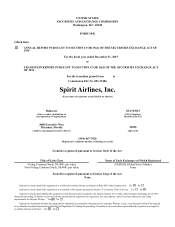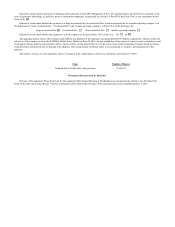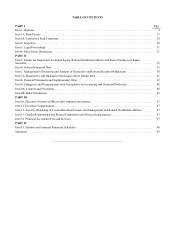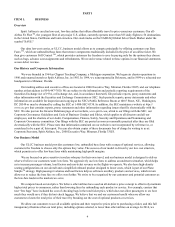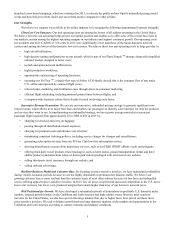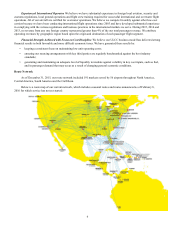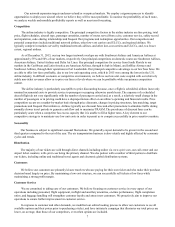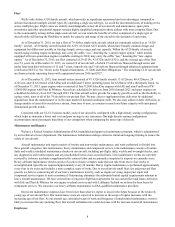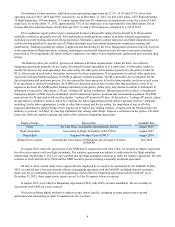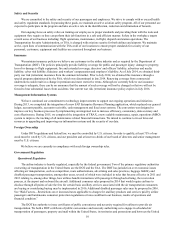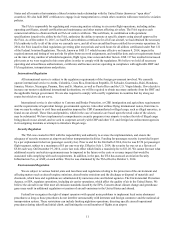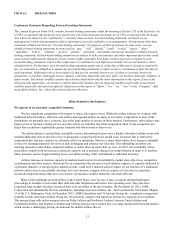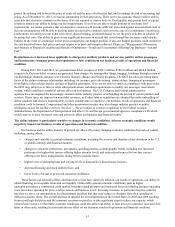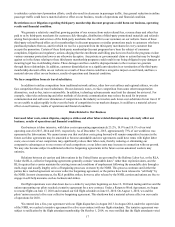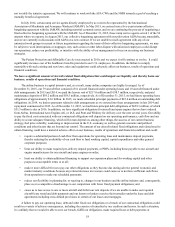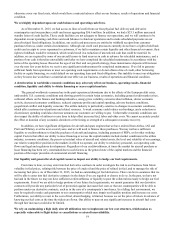Spirit Airlines 2015 Annual Report Download - page 9
Download and view the complete annual report
Please find page 9 of the 2015 Spirit Airlines annual report below. You can navigate through the pages in the report by either clicking on the pages listed below, or by using the keyword search tool below to find specific information within the annual report.
9
Our business is labor intensive, with labor costs representing approximately 23.2%, 19.9% and 19.1% of our total
operating costs for 2015, 2014 and 2013, respectively. As of December 31, 2015, we had 1,266 pilots, 2,075 flight attendants,
35 flight dispatchers, 499 mechanics, 517 airport agents/other and 455 employees in administrative roles for a total of 4,847
employees. As of December 31, 2015, approximately 73% of our employees were represented by four labor unions. On an
average full-time equivalent basis, for the full year 2015, we had 4,326 employees, compared to 3,722 in 2014.
FAA regulations require pilots to have commercial licenses with specific ratings for the aircraft to be flown and be
medically certified as physically fit to fly. FAA and medical certifications are subject to periodic renewal requirements,
including recurrent training and recent flying experience. Mechanics, quality-control inspectors and flight dispatchers must be
certificated and qualified for specific aircraft. Flight attendants must have initial and periodic competency training and
qualification. Training programs are subject to approval and monitoring by the FAA. Management personnel directly involved
in the supervision of flight operations, training, maintenance and aircraft inspection must also meet experience standards
prescribed by FAA regulations. All safety-sensitive employees are subject to pre-employment, random and post-accident drug
testing.
The Railway Labor Act, or RLA, governs our relations with labor organizations. Under the RLA, our collective
bargaining agreements generally do not expire, but instead become amendable as of a stated date. If either party wishes to
modify the terms of any such agreement, they must notify the other party in the manner agreed to by the parties. Under the
RLA, after receipt of such notice, the parties must meet for direct negotiations. If no agreement is reached, either party may
request the National Mediation Board, or NMB, to appoint a federal mediator. The RLA prescribes no set timetable for the
direct negotiation and mediation process. It is not unusual for those processes to last for many months, and even several years.
If no agreement is reached in mediation, the NMB in its discretion may declare at some time that an impasse exists. If an
impasse is declared, the NMB proffers binding arbitration to the parties. Either party may decline to submit to arbitration. If
arbitration is rejected by either party, a 30-day “cooling off” period commences. During that period (or after), a Presidential
Emergency Board, or PEB, may be established, which examines the parties’ positions and recommends a solution. The PEB
process lasts for 30 days and is followed by another “cooling off” period of 30 days. At the end of a “cooling off” period, unless
an agreement is reached or action is taken by Congress, the labor organization and the airline each may resort to “self-help,”
including, for the labor organization, a strike or other labor action, and for the airline, the imposition of any or all of its
proposed amendments and the hiring of new employees to replace any striking workers. Congress and the President have the
authority to prevent “self-help” by enacting legislation that, among other things, imposes a settlement on the parties. The table
below sets forth our employee groups and status of the collective bargaining agreements.
Employee Groups Representative Amendable Date
Pilots Air Line Pilots Association, International (ALPA) August 2015
Flight Attendants Association of Flight Attendants (AFA-CWA) August 2007
Dispatchers Transport Workers Union (TWU) August 2018
Ramp Service Agents International Association of Machinists and Aerospace Workers
(IAMAW) June 2020
In August 2014, under the supervision of the NMB and in conjunction with AFA-CWA, we reached a tentative agreement
for a five-year contract with our flight attendants. The tentative agreement was subject to ratification by the flight attendant
membership. On October 1, 2014, we were notified that the flight attendants voted not to ratify the tentative agreement. We will
continue to work with the AFA-CWA and the NMB toward a goal of reaching a mutually beneficial agreement.
On July 8, 2014, certain ramp service agents directly employed by us voted to be represented by the IAMAW. In May
2015, we entered into a five-year interim collective bargaining agreement with the IAMAW, including material economic
terms, and we are continuing the process of negotiating a final collective bargaining agreement with the IAMAW. As of
December 31, 2015, these ramp service agents served 1 of the 56 airports where we operate.
In August 2015, our Collective Bargaining Agreement (CBA) with ALPA, became amendable. We are currently in
discussions with ALPA on a new contract.
We focus on hiring highly productive employees and, where feasible, designing systems and processes around
automation and outsourcing in order to maintain our low cost base.

